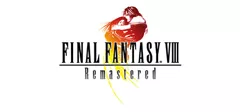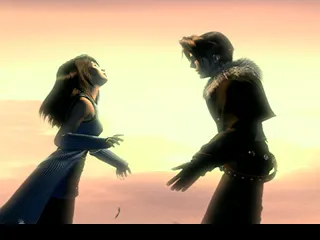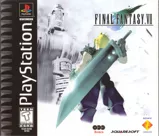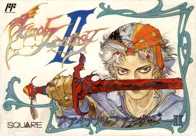Final Fantasy VIII
Description official descriptions
Squall Leonhart is a young man in training to become of member of SeeD - a mercenary organization and the goal of all young students in Balamb Garden. Squall is not a particularly friendly guy and has troubles with his fellow students and teachers. On the eve of his graduation hostilities break out between the city-states of Galbadia and Dollet. As their final test, Squall and three other students are sent on a mission to assist in the fight against Galbadia. In the process they discover that there are other characters pulling strings from behind the stage, and eventually uncover a mystery that involves two decades of secrets hidden both from the world and from themselves.
Final Fantasy VIII is set in a "retro" environment reminiscent in some ways of the 1960's, with a few sci-fi and plenty of supernatural elements mixed in. The basic system resembles those of its predecessors: the player navigates a party of characters over a world map, accessing various locations and fighting randomly appearing enemies in turn-based combat of the series' trademark ATB (active time battle) variety. However, character development system has been re-designed.
Player-controlled characters in the game have no defined character classes. They can be customized by equipping magic spells, which can be "drawn" from enemies in battles. When used in combat, spells act like expendable items; there are no MP (magic points) in the game. When equipped, they act like armor, raising or lowering character parameters, including resistances to various kinds of magic (elemental, status-changing, etc.).
Monster summons (called Guardian Forces in the game) play a very important role in the customization process. They can be "junctioned" to to the characters, acquire ability points (AP) earned from battles along with experience, learn and "teach" characters new abilities, and can also be summoned in battles. Each character can also execute unique powerful attacks or support actions when his or her hit points are low. Many of these attacks require the player to press specific buttons at the right moment to increase their power.
New weapons are constructed by collecting materials and bringing them to a blacksmith. The player does not acquire money from random enemies, but instead receives paychecks over time based on the player character's SeeD rank. This rank increases when the characters defeat enemies in battles without summoning Guardian Forces; when the player takes SeeD tests within the game; or, occasionally, when the player chooses a correspondent action or decision for the protagonist during some of the missions. Payments are regular and are calculated by the amount of steps the characters make.
Visually, the game resembles its predecessor, featuring 3D graphics for battles and world map exploration, and pre-rendered backgrounds for individual locations. The game's 3D character models are realistically proportioned (as opposed to the "super-deformed" character graphics of the previous game), and the influence of anime art is less noticeable.
Like the previous installment, Final Fantasy VIII features several mini-games, the most prominent of which is the card game Triple Triad. Cards can be won in matches or acquired through side quests or by transforming enemy monsters. Many characters in the game can be challenged to a game of Triple Triad, so it is always possible to take a break from saving the world to play cards with the locals.
Spellings
- Финальная Фантазия 8 - Russian spelling
- ファイナルファンタジーVIII - Japanese spelling
- 太空戰士 8 - Traditional Chinese spelling
- 最终幻想8 - Simplified Chinese spelling
Groups +
- Console Generation Exclusives: PlayStation
- Fantasy creatures: Dragons
- Final Fantasy games
- Final Fantasy series
- Game feature: Original theme song
- Games referenced in movies
- Games with post-credits scene or gameplay
- Middleware: Bink Video
- PlayStation Greatest Hits releases
- PlayStation Platinum Range releases
- Video games turned into board / card games
Screenshots
Promos
Videos
Add Trailer or Gameplay Video +1 point
See any errors or missing info for this game?
You can submit a correction, contribute trivia, add to a game group, add a related site or alternate title.
Credits (PlayStation version)
113 People (107 developers, 6 thanks) · View all
| Executive Producer | |
| Director | |
| Music | |
| Main Programmer | |
| Battle System Designer | |
| Character Design / Battle Visual Director | |
| Art Director | |
| Scenario Writer | |
| Image Ilustration | |
| Movie Director | |
| Movie Character Director | |
| Character Modeling Director | |
| Real-Time Polygon Director | |
| Battle Effect Director | |
| Motion Director | |
| Card Game Director / Battle Camera Director | |
| Lead Field Designer | |
| Event Script Programmer | |
| Battle Programmer | |
| Event Director | |
| Map Director | |
| [ full credits ] | |
Reviews
Critics
Average score: 88% (based on 70 ratings)
Players
Average score: 4.0 out of 5 (based on 350 ratings with 26 reviews)
Like any true work of art...It only gets better with age.
The Good
First off...anyone who watches the intro to this game will be hooked.
The combination of the groundbreaking (for 1999) cgi effects and Nobuo Uematsu's intense score creates a cinematic experience that was unmatched in it's day. Even today, with 6 years of hardware and software evolution, few games can match the passion, excitement and mystery inherent in the INTRO of this game.
When the game actually begins, you are thrust into the role of Squall Lionhart, one of the most complex characters ever to appear in a video game. Squall is training to become a mercenary at an elite academy, and the story is centered on him and the group of soldiers that he leads. Squall is a pretty deep guy, with the type of complex personality that is more common in novels than in video games. On the surface he is a pretty uncaring dude, but as the game progresses you find out that most of his affect is due to a pretty crummy childhood (i.e. the boy has some abandonment issues to say the least.)
In fact the characterization inherent in this game is actually, for me, one of the best features of this game. Unlike FF-7 (or 5, or 3, or 1...what is it with these odd numbered FF games....) the characters in this game have real motivations, fears, etc. they are not interchangeable cardboard cut-outs. To put it simply, each character in the game has a reason to be the way they are, and the game delves into each character's psyche enough to make them all three dimensional characters. This is truly a character driven game, which is a bit of a departure from games like FF-7.
Another great feature of this game is the Junction system. This tends to be a "love it or leave it" feature of the game, and as a veteran of EVERY Final Fantasy game (except XI) I would have to say it lives up the expectations of fans of the series. The system if flexible, and powerful, without ever being too munchkin-y. It also tends to be the type of system that is really re-playable, since you can drastically alter stat progression and power levels for your characters when you know how to really use the system. Granted, some people will not like the junction system at first glance (I have a buddy who's a FF fanatic who WILL NOT play this game because of it) but I assure that when you spend some time with it you will find that it is one of the most flexible systems within the FF family of games.
Another feature that I really like is the fact that money is not as important in this game as in most RPGs, and monsters don't drop gil when they die. Money is normally only gained through your paycheck from SEED (the mercenary company your team works for.) Personally I feel that this adds a bit of needed realism to the standard RPG formula, I know that complaining about realism in a game populated with man-eating, magic-using monsters is kinda silly, but it's one of those RPG-isms that tends to bug me. (I mean where do these monsters get all their cash....stealing lunch money from school kids?) Instead, money is only used for things that tend to be "extras", like healing items, and car rentals.
Another great feature of this game is the Triple Triad card game. Your character can play this game against NPCs and build up a collection of rare cards that can be modded into rare items. If you delve into Triple Triad, you will find yourself ahead of the curve quite often in this game, as you will have access to spells and weapons that you would normally have to wait to get.
In closing I would have to say, this is a BIG game, bigger than FF-7. That being said though, it tends to be a bit more quaint than 7 in it's general scale, most of the conflict early in the game revolves around inter-city disputes, as opposed to the constant "save the world" vibe of 7. This scale helps center the story on the characters, as opposed to the world, which makes it all the more identifiable.
The Bad
I'm a pretty big fan of this game, so it's fairly hard for me to find points to criticize, but here goes.
I would have to say that the complexities of the junction system is something that took more than one play through to really learn. As this is about a 40 hour game, playing through once just to learn the ins and outs of the junction system is an investment of time that some people just will not make. While I like the system, I would have to say that more documentation on it from Square would have been nice. Granted, now you can just grab a FAQ and learn it, but still, a couple of extra pages in the manual or a better tutorial would have been nice.
Another feature that I do not really like it the in-game tutorial system. On your first playthrough it's essential, as it explains processes that are not examined in the game manual. On your second and subsequent playthroughs it can be a bit of a time waster, I really think it would have been nice it Square would give you the option of turning the tutorials off.
I guess the last thing I will mention is that, on my first playthrough, the lack of armor and the weapon modification system kinda bothered me. Granted once I learned the system better (i.e. your Strength stat determines how much damage you do with physical attacks; Vitality reduces physical damage like armor) I never had a problem again, but it's worth mentioning.
The Bottom Line
An essential part of the Final Fantasy series of games. If you haven't played it you should.
PlayStation · by Edward Beezy (27) · 2005
The fantasy to start with and it didn't disappoint
The Good
It surely have revolutionize the game standard and expectation to match the fantastic storyline. The setting is what i loved the most, then the clip's graphic, battling system, character development and summoning. You may find that i have quite a low expectation, but it was the first and best game i ever played at that time, it was a work of a flawless piece of art.
The Bad
Although i am not a good critic, the fourth disc rather confuse and disappoint me. i say the game is getting a bit too serious for that the plots and events in the previous discs did not have enough information to sustain it. Or rather, there is too many events in the third disc as compare to the first.
The Bottom Line
It's the fantasy that leave people wondering.
PlayStation · by Mike Wazoski (7) · 2005
It doesn't do justice to its predecesors.
The Good
There are lots of original concepts to be found. It gets rid of a lot of RPG cliches such as gathering gold, armors and weapons. Armor is virtually nonexistent, your starting weapon is the standard 1 for your character throughout the whole game. You get paid regualrly so gold is no longer a big reason for killing random enemies. The graphics on the Guardian Forces are impressive the first couple of times you see them, but they get very repetitive.
The Bad
You can't skip the animations on the Guardian Force attacks. The grphics are sub par, they're left in the original playstation resolution which makes them low-res on todays PC's. A lot of the original concepts are poorly implimented.The sounds sound tinny and distant.
The Bottom Line
If you're a Final fantasy fanatic is the only way i can recomend this game. A console port that squaresoft put no effort into. They didn't take advantage of the computers superior performance.
Windows · by jeremy strope (160) · 2000
Discussion
| Subject | By | Date |
|---|---|---|
| Game with downloadable sounds soundbank | MerlynKing | Oct 24, 2016 |
| A question-spoilers! | GAMEBOY COLOR! (1990) | Apr 24, 2011 |
| OMG!!! TEH DEVIL!!! | The Fabulous King (1332) | Jul 24, 2007 |
Trivia
1001 Video Games
The PS1 version of Final Famtasy VIII appears in the book 1001 Video Games You Must Play Before You Die by General Editor Tony Mott.
Development
- During production of the game, there were plans to originally call the Rinoa character "Lenore".
- Parasite Eve was the 'testing ground' for the cinematic graphics used in FFVIII.
Innovations
As of 2013, Final Fantasy VIII is the first and the only Final Fantasy game where the playable characters don't equip any armor.
Music
The music in this game was originally composed and recorded as Dolby Digital 5.1, then "dumbed down" to normal stereo for the actual release. The original DD 5.1 score was rumored to be the one to be used in a PlayStation 2 re-release.
Ratings
When it was first released as a demo, it was rated M for strong language but was later toned down to a T rating.
References
- Some names of the Guardian Forces (monsters you can summon in Final Fantasy VIII) are taken from mythologies of different nations. Quetzalcoatl is one of the main gods in the mythology of Central America's Indians; Shiva is God in Hinduism (he appears as a feminine incarnation in the game, although he is normally regarded as male); Diabolos is Greek for "devil"; Cerberus is a three-headed dog which guards the gates of Hades in Greek mythology; Siren is a beautiful and dangerous demi-goddess, also from the Greek mythology; Leviathan is Hebrew for "whale", this word is used to describe the sea monster that swallowed the prophet Jonas in Old Testament.
- The game's most poweful GF is called Eden. This is actually the name of the paradise, "Garden of Eden" (Hebrew "Gan Eden"), from where Adam and Eve were expelled, according to the first book of Moses from the Old Testament. Why is the most powerful GF a garden? Because the universities where the heroes of the game study and train are called gardens. It is logical the most powerful garden is also the most powerful weapon.
- In Esthar there is a shop called Cloud's Shop, a reference to Final Fantasy VII.
- You can spot UFOs during battles in four areas of the world. The sightings are used in the 'Pupu card' sidequest, and can only be seen from the second disk onwards.
References to the game
- In the 2004 Olympics, one of the American synchronized swimming teams chose to use a piece of music from Final Fantasy VIII as their background music . They used the song Liberi Fatali, the game's main theme
- The game is featured in the movie Charlie's Angels. It's the game the two kids are playing in the scene where Drew Barrymore drops naked from Knox's house. Interestingly enough both kids seem to be playing it at the same time, apparently nobody figured to tell the production team that the game was single-player only.
Summonings
When the game came out, the #1 complaint everyone had was that there was no way of skipping the summoning animations - which were essential for making it through the early stages of the game. The creators claimed this was entirely intentional, and that it was somehow vital to the plot that the players be forced to sit through the same minute-long animations hundreds of times. They never changed it in FFVIII (even the later PC adaptation) but oddly, all subsequent Final Fantasy games with summonings include the option to shorten the animation...
Tech demo
The ballroom dance scene was used as the basis for a PlayStation 2 tech demo, showing that the PS2 was powerful enough to render the scene in real-time.
Version differences
- The PC version includes a mini-game called Chocobo World. Previously, this was only available with the Japanese PSX version through the Dex Drive.
- Seifer and Zell, two important characters of Final Fantasy VIII, were renamed to Cifer and Xell, respectively, in the German version, probably because the original names are common German family names and might have possibly offended their innocent bearers.
-
Disc 3 of the Windows version (US release) has a hidden audio track. It contains the song Eyes On Me, sung by Faye Wong. This song was released in Japan as a CD single and was part of the original soundtrack.
-
The original Playstation release included a Chocobo World minigame which required access to a PocketStation, a console that was only released in Japan. Gamers in other territories could only access that by importing a PocketStation from Japan. This was the only way to access some rare items in the game.
Information also contributed by Alan Chan, Foxhack, j. jones, NightKid32, Rey Mysterio, Tiago Jacques, YID YANG, WizardX and Zovni
Analytics
Upgrade to MobyPro to view research rankings!
Related Sites +
-
FF-Fan
A fansite that offers all kinds of information on the entire Final Fantasy franchise, including walkthroughs, game media, discussion boards and fan art. -
FF8 Hints
Final Fantasy VIII hints and solutions -
Final Fantasy Extreme
Site that contains movies, wallpaper, codes, guides, walkthroughs, and general information on the Final Fantasy series. -
GameFaqs Files
Comprehensive links to numerous Final Fantasy VIII files on GameFaqs -
OC ReMix Game Profile
Fan remixes of music from Final Fantasy VIII. -
Wikipedia: Final Fantasy VIII
Information about Final Fantasy VIII at Wikipedia
Identifiers +
Contribute
Are you familiar with this game? Help document and preserve this entry in video game history! If your contribution is approved, you will earn points and be credited as a contributor.
Contributors to this Entry
Game added by Matthew Bailey.
PlayStation 3, PSP added by Charly2.0. PS Vita added by GTramp. PlayStation added by Grant McLellan.
Additional contributors: MAT, Unicorn Lynx, Jeanne, Silverblade, DarkDante, DreinIX, —-, Paulus18950, Patrick Bregger, Thomas Thompson, Lain Crowley, Rik Hideto, FatherJack, 64er.
Game added March 26, 2000. Last modified June 24, 2024.





















